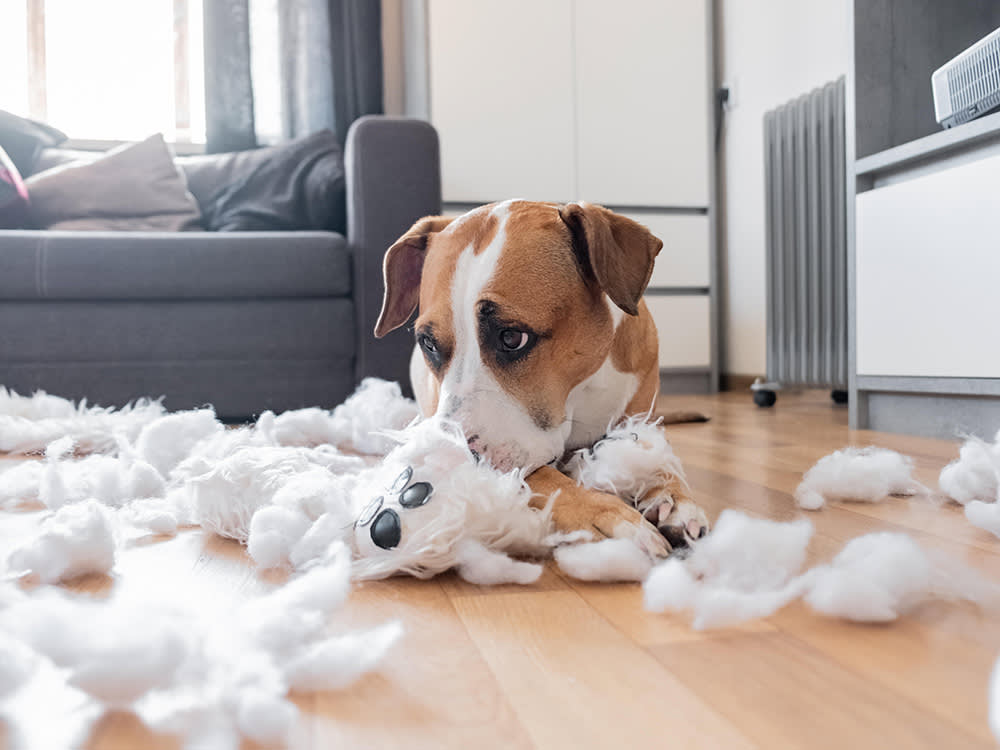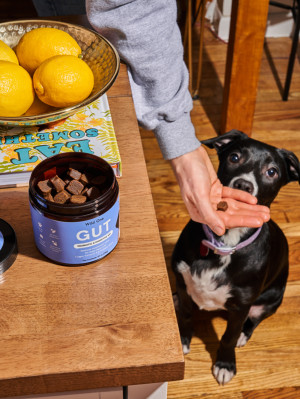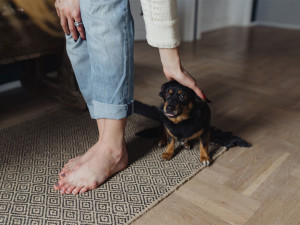Pica in Dogs: Causes, Symptoms, and Treatment
Why, oh why, is your dog eating everything they shouldn’t?
In This Article:
What Is Pica? What Are the Causes of Pica? Pica Symptoms How Vets Diagnose Pica Pica Treatments Natural Remedies for Pica Can Dogs Recover From Pica?
Pica is a disorder that causes dogs to eat non-food items. (Yes, it does exist outside of that episode of Grey’s Anatomy you watched.) Though most dog parents have experienced their pup chewing on and eating random items to some degree — especially with puppies and younger dogs — pica is a more consistent, long-lasting behavior.
While it can get annoying, pica can also put your dog at risk for health complications, depending on what they eat. So, if you’re finding more and more unmatched socks or squeaker-less toys, it is important to see a veterinarian to figure out what’s causing this eating behavior so you can start treating it.
What is pica?
Pica is a condition in which dogs repeatedly eat non-edible items that do not benefit them. A dog with pica disorder may ingest anything from rocks to fabric to drywall to dirt — and everything else they can get their paws on.
How much do you spend on your pet per year?
Some dogs may do this once, or just occasionally, and that does not qualify as having pica. But dogs with pica will do this frequently and cannot be easily redirected or deterred from the behavior. This can be a frustrating condition for pet parents to manage, because these behaviors become destructive when dogs eat things of value around the home. More importantly, they also put dogs at risk for dangerous complications, which incur unexpected and very expensive emergency vet visits.
There are many underlying causes for pica, so it’s important to see your vet if you notice your dog continuing to eat non-food items. The sooner you and your vet can figure out the underlying cause and start the right treatment, the better the outcome for your dog, your shoe collection, and your relationship with your pup.
What are the causes of pica in dogs?
Causes of pica in dogs include both medical and behavioral conditions. Your vet can help you distinguish between the two of them.
Medical causes
Inflammation in the digestive tract — brought on by things like intestinal parasites, food allergies, exocrine pancreatic insufficiency (EPI)opens in new tab, and protein-losing enteropathyopens in new tab — can interfere with the absorption of nutrients, which can lead to pica. Along those same lines, vitamin and mineral deficiencies in a dog’s diet may also be to blame. This includes vitamin B12, as well as anemia or low red-blood-cell counts.
Behavioral causes
Pica can also arise from behavioral conditions, such as anxiety, compulsive disorder, and/or boredom. This can only be confirmed after medical causes are ruled out with a thorough diagnostic evaluation.
What are the symptoms of pica in dogs?
Signs of pica in dogs may vary, depending on the underlying cause of their condition. The main symptom, which defines the condition, is continuously eating non-food items. Dogs with pica often vomit as well, but it’s usually difficult to determine if this is the result of eating foreign material, versus part of the underlying cause.
Other symptoms can lend clues to the underlying cause, so it is a good idea to keep track of any other behavioral or physical abnormalities you notice with your dog. This can help your vet put together a complete picture of your dog’s condition and focus on the most likely causes and effective treatments.
How do veterinarians diagnose pica in dogs?
Diagnosing pica in dogs takes patience because there are many possible causes to work through. Your vet will start by taking a thorough history to understand the nature of the behavior and then performing a complete physical exam. From there, blood work and imaging may be done to get a look at the digestive tract and organ function. More in-depth cases may require a biopsy of the digestive tract for further analysis.
If all of the test results are normal, there is likely a behavioral cause for pica. A veterinarian and/or veterinary behaviorist can help you to determine which behaviors are causing the pica, based on observations and a behavioral evaluation.
What are the treatment options for pica in dogs?
Treatment for pica in dogs is largely determined by the underlying cause, so it is very important to trudge through all of the trips to the vet and all of the diagnostic tests to get an accurate picture of what’s going on with your pup.
If your vet discovers an underlying medical condition, it will likely be treated with medication and/or a special diet to help resolve your dog’s desire to eat foreign objects. If your vet determines that your dog’s pica is behavioral, treatment may involve a combination of behavior modification techniques, mental enrichment, and medications. It’s important to have a thorough behavioral analysis performed by your vet and/or a veterinary behaviorist to understand if your dog’s behavior is related to anxiety, compulsive disorder, or boredom.
Are there natural remedies for managing pica in dogs?
Pica results from a serious, underlying medical or behavioral condition, so home remedies alone are not sufficient to treat or cure the condition. These cases need aggressive treatment to prevent serious complications. However, it is helpful to complement medical treatments with some of the below home remedies for pica in dogs.
Dog-proofing
All homes should be dog-proofed to some degree. If you live with a dog who has pica, you’ll have to be even more vigilant about keeping temptation out of reach. Be especially mindful of removing objects that may be toxic if consumed, such as cleaning supplies, toxic plants, human medications, and certain foods. Consider crate-training your dog and/or blocking off parts of your home so they can roam safely.
Basket muzzle
Dogs who have repeatedly eaten foreign objects can be trained to comfortably wear a basket muzzle, which prevents them from eating things but is not snug around their mouth. This way they can still pant, take treats from you, drink water, and wear the muzzle comfortably.
You should use positive reinforcement (like treats and praise) to train dogs to wear it, so it is associated with good things and not seen as a punishment. The basket muzzle can be a lifesaving tool to keep them safe when you can’t completely dog-proof their environment, such as on walks, or when they are unsupervised for short periods.
Supplements
Because some dogs have digestive problems that cause their pica, they may benefit from probiotics. Probiotics provide live strains of beneficial microbes to the gut and can help with some digestive conditions. Probiotics alone cannot cure the conditions that lead to pica, so it is important to work with your vet to get the best treatment plan in place for your dog.
Exercise
All dogs need to get enough daily exercise to stay mentally and physically fit. This is especially important for dogs with certain behavioral conditions, including those that may cause pica. Some dogs will need an hour or more of intense activity, depending on their needs, so be sure you are keeping up. Whether it is an early morning run, daily walks with a dog walker, doggie daycare, or a post-work play session, you will see a big difference in your pup when they are getting enough exercise.
Mental enrichment
All dogs need mental enrichment, and dogs who have pica due to behavioral issues may need additional challenges throughout their day to keep their minds busy. This can include training sessions, interactive toys, puzzle feeders, obstacle courses, and more. If you need ideas on what will be best for your pup, consult a trainer or behaviorist who is familiar with pica.
Diet
Some dogs with pica may need a special prescription diet to treat their underlying medical conditions, so be sure to consult with your vet before changing your dog’s diet. If your dog is not on a special diet, they may benefit from small, frequent meals throughout the day. It can also help to use a slow feeder and/or different puzzle feeders to make meals last longer and provide mental enrichment at the same time.
Are dogs able to recover from pica?
You may be wondering how to cure pica and what the likelihood is of a complete recovery. This depends largely on the underlying cause of their condition. In cases where a clear medical cause is diagnosed and dogs are successfully treated, their signs of pica should completely resolve.
For dogs who have behavioral causes driving their pica, long-term management is usually more realistic than a complete cure, though it depends on the specific dog and their condition. A dog’s best chance of successful recovery and/or cure depends on an accurate diagnosis and pursuing the most aggressive, consistent treatment.
How to help dogs recover and manage pica
All dogs with pica will also benefit from preventative strategies aimed at keeping them safe and keeping foreign objects out of reach. This helps avoid the serious consequences of eating objects that could be toxic or cause intestinal obstructions. The more proactive pet parents can be with treatment and preventative strategies, the better chance a dog with pica has for recovery and a long, happy life with their family.
Bottom line
Pica is a condition where dogs consistently eat non-food items. This means more than once or twice — it’s a constant issue.
Pica can be caused by both medical and behavioral issues, so consult your veterinarian to get to the bottom of pica in your dog.
Eating non-food items can be dangerous to dogs, so you’ll want to get an accurate diagnosis to find the best treatment or management option for your dog.
FAQs
Can pica be a sign of a more serious health problem?
Yes, pica always has an underlying cause. These causes may be medical or behavioral and will require an accurate diagnosis to treat them properly.
How do you test for pica in dogs?
Testing for pica starts with checking for underlying medical conditions. This includes an exam, blood tests, and an ultrasound. If no underlying medical conditions are discovered, a behavioral assessment is done by a vet to determine if there is a behavioral cause.
Can pica in dogs be a sign of stress or anxiety?
Yes, behavioral conditions can cause pica. The most common ones include anxiety, compulsive disorders, and/or boredom.
Are specific breeds more prone to pica?
Any dog can develop pica, but certain breeds are more proneopens in new tab to medical and behavioral conditions that may lead to pica. These breeds — such as Labradors and Dachshunds — tend to be more high-energy or prone to anxiety.
References
Neiger, Reto. ”Protein-Losing Enteropathy (PLE) in Dogs.” World Small Animal Veterinary Association World Congress Proceedings, 2013. https://www.vin.com/apputil/content/defaultadv1.aspx?pId=11372&catId=35322&id=5709878opens in new tab.
Steiner, Jorg M. “Exocrine Pancreatic Insufficiency in Dogs and Cats.” Merck Veterinary Manual. Oct 2020. https://www.merckvetmanual.com/digestive-system/the-exocrine-pancreas/exocrine-pancreatic-insufficiency-in-dogs-and-catsopens in new tab.
“Unusual Eating Habits in Dogs and Cats.” UC Davis College of Veterinary Medicine. https://www.vetmed.ucdavis.edu/sites/g/files/dgvnsk491/files/inline-files/Unusual_eating_habits.pdfopens in new tab.












